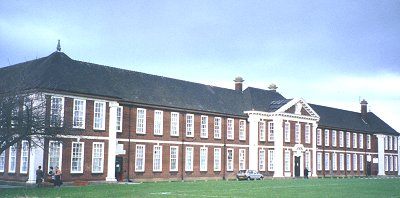|

Listing: School. 1929-30; by Col. G. C. Lowbridge. ...
Included as a particularly imposing example of a local authority
high school of the inter-war period; these buildings were in the
vanguard of state secondary education to an advanced level for
girls.
Local Listing: former Bilston Girls High School, opened 1929.
Queen Anne style. Landmark building.
Comment:
Duncan Nimmo writes: the school was founded in 1918/19 and was first
located in Brueton House (now Bilston Library). It moved to purpose built
accommodation in Green Lanes in 1930. The place became a Sixth Form College in
1976 and part of Bilston College of FE in 1983/4.
The building was designed by the architect to the Staffordshire Education
Committee, Colonel G. C. Lowbridge, M.C., in 1929. His handsome "artist's
impression", and possibly some of the original working plans, are preserved in
the Building Surveyor's office at the Westfield Road site of Wolverhampton
College.
The style of the building is sometimes known as "(neo) Queen Anne". It is
unquestionably attractive, with strongly marked symmetry and decorative
trimmings, worked in quality materials. At the same time it is, in architectural
history terms, backward-looking, perhaps "behind the times", more "Edwardian"
than "modernist". The most prominent local comparison might be with the
Wolverhampton Civic Halls. Though only five years later, this building belongs
to an architecturally different world, of undoubted modernism.
There are two other buildings in Wolverhampton by Lowbridge in the same
"Queen Anne" style and to which the same comments therefore apply: Wolverhampton
Grammar School's new block along Merridale Lane, of 1930, and the much more
ambitious main building of the Technical College (now the University) in
Wulfruna Street, begun in 1931. The external similarity between the BGHS and WGS
buildings is very close; conversely it seems to me that the main foyers of BGHS
and the Technical College are very alike).
Given the prominence of these three buildings in a small part of his
territory, Lowbridge is obviously an architect to be reckoned with. On the other
hand, the conservatism of his style in these buildings perhaps make it unlikely
that they would pass the stiff criteria for 20th century statutory listing. The
Staffordshire Conservation Officer confirms that none of his other buildings is
listed.
Frank Sharman adds: Duncan's note was written before the
building was listed. In fact the note was based on Duncan's report which
lead directly to the building's being listed - despite his reservations about
the listing system. This is a case where a spot listing actually operated
to save the building from wholesale site clearance. It is also a case of a
building's being locally listed before it was nationally listed.
When Bilston Community College was taken over to become part of the City of
Wolverhampton College, the new owners almost immediately abandoned this building
and sold it off for development. As a result of the listing plans have now
(mid 2004) been submitted for residential development of the site. These
proposals retain this building and convert it into flats. New building
would create an open side courtyard in front of the old building.

|